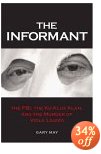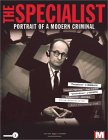| Jack the Ripper's Black Magic Rituals by Ivor J. Edwards -- Satanism, black magic, serial murder: a study of Jack the Ripper maintains he was Dr. Robert Donston Stephenson, an army surgeon, occultist, and magician, who may have murdered and dismembered his own wife before his spree in Whitechapel.
Bloody Falls of the Coppermine: Madness, Murder, and the Collision of Cultures in the Arctic, 1913 -- by McKay Jenkins-- In the winter of 1913, high in the Canadian Arctic, two Catholic priests set out to reach a group of isolated Eskimos to convert in bleak Barren Lands, where the Coppermine River meets the Arctic Ocean. After arriving, the priests were murdered, and their livers eaten. It took nearly two years for word of the crime to reach civilization. Canadian Mounties made a three-3000 mile search for the murderers and returned with two Eskimos, Stone Age relics, to stand trial.
Manx
Murders: 150 Years of Island Madness, Mayhem and Manslaughter by
Keith Wilkinson The Isle of Man, an island
in the north Irish Sea between England, Scotland, Ireland
and Wales,
over the last 150 years. Each murder is described in the
context of events on the island.
|

|
It
is true that history cannot satisfy our appetite when we
are hungry, nor keep us warm when the cold wind blows.
But it is true that if younger generations do not understand
the hardships and triumphs of their elders, then we will
be a people without a past. As such, we will be like water
without a source, a tree without roots.
--Wall inscription, New York
A History of Violence -- In sixteenth-century Paris, cat-burning was a popular entertainment.
 The Italian Boy: A Tale of Murder and Body-Snatching in 1830's London Sarah
Wise -- Before his murder in 1831, the "Italian boy" was one of thousands of orphans on the streets of London, moving among the con men, begging for pennies. When his body was sold to a London medical college, the suppliers were arrested for murder. Their trial unveiled London's trade in human corpses carried out by body-snatchers-or "resurrection men" who
killed to satisfy the cadaver market: the fresher the body, the
higher the price. Wise reconstructs the boy's murder and squalor that swallowed
the 14-year-old long before his corpse appeared on the
slab. The Italian Boy: A Tale of Murder and Body-Snatching in 1830's London Sarah
Wise -- Before his murder in 1831, the "Italian boy" was one of thousands of orphans on the streets of London, moving among the con men, begging for pennies. When his body was sold to a London medical college, the suppliers were arrested for murder. Their trial unveiled London's trade in human corpses carried out by body-snatchers-or "resurrection men" who
killed to satisfy the cadaver market: the fresher the body, the
higher the price. Wise reconstructs the boy's murder and squalor that swallowed
the 14-year-old long before his corpse appeared on the
slab.
The French Quarter: An Informal History of the New Orleans Underworld by Herbert Asbury -- Home to the notorious "Blue Book," which listed the names and addresses of every prostitute living in New Orleans's raucous red-light district. The underworld had bordellos, gambling with violent street crime. Two prostitutes Mary Jane "Bricktop" Jackson and Bridget Fury, became famous after murdering their associates.
 On the Waterfront: The Pulitzer Prize-Winning Articles That Inspired the Classic Film andTransformed the New York Harbor by Budd Schulberg, Haynes Johnson, Malcolm Johnson On the Waterfront: The Pulitzer Prize-Winning Articles That Inspired the Classic Film andTransformed the New York Harbor by Budd Schulberg, Haynes Johnson, Malcolm Johnson --The stories that shook the nation for the first time since their original publication in 1948. Until the mid-twentieth century, organized crime ruled New York's waterfront. With the threat of communism, the inhumane treatment of longshoremen condoned by the unions, and the disappearance of anyone who spoke against the system, Malcolm Johnson's series "Crime on the Water Front" appeared in the New York Sun, revealing a violent underworld that influenced New York politics, society, and industry. Johnson's investigation forced the government to changes labor laws. Now, these Pulitzer Prize-winning articles tell a riveting story of mobsters, murder, faith, and the victory of fair play. Malcolm Johnson's son, Haynes Johnson, also a Pulitzer Prize winner, discusses the impact the series had pon his family, and additional reporting by Budd Schulberg, author of the Academy Award-winning screenplay On the Waterfront. --The stories that shook the nation for the first time since their original publication in 1948. Until the mid-twentieth century, organized crime ruled New York's waterfront. With the threat of communism, the inhumane treatment of longshoremen condoned by the unions, and the disappearance of anyone who spoke against the system, Malcolm Johnson's series "Crime on the Water Front" appeared in the New York Sun, revealing a violent underworld that influenced New York politics, society, and industry. Johnson's investigation forced the government to changes labor laws. Now, these Pulitzer Prize-winning articles tell a riveting story of mobsters, murder, faith, and the victory of fair play. Malcolm Johnson's son, Haynes Johnson, also a Pulitzer Prize winner, discusses the impact the series had pon his family, and additional reporting by Budd Schulberg, author of the Academy Award-winning screenplay On the Waterfront.
 The Informant: The FBI, the Ku Klux Klan, and the Murder of Viola Liuzzo by Gary May The Informant: The FBI, the Ku Klux Klan, and the Murder of Viola Liuzzo by Gary May -- May reveals the murder of civil rights worker Viola Liuzzo, shot to death by the violent Birmingham Ku Klux Klan after Martin Luther King’s Voting Rights March in 1965. The case was solved because one Klansman present was Gary Thomas Rowe, an FBI informant. Rowe’s testimony were heralded as a triumph of law enforcement. But Rowe’s history of collaboration with the Klan and the FBI was complex. Based on FBI and Justice Department Records, The Informant demonstrates that in their efforts to protect Rowe’s cover, the FBI became an accessory to grotesque crimes of the Civil Rights era. -- May reveals the murder of civil rights worker Viola Liuzzo, shot to death by the violent Birmingham Ku Klux Klan after Martin Luther King’s Voting Rights March in 1965. The case was solved because one Klansman present was Gary Thomas Rowe, an FBI informant. Rowe’s testimony were heralded as a triumph of law enforcement. But Rowe’s history of collaboration with the Klan and the FBI was complex. Based on FBI and Justice Department Records, The Informant demonstrates that in their efforts to protect Rowe’s cover, the FBI became an accessory to grotesque crimes of the Civil Rights era.
The Autobiography Of Medgar Evers: A Hero's Life and Legacy Revealed Through His Writings, Letters, and Speeches by Myrlie Evers-Williams  -- The life of Medgar Evers, one the greatest leaders of the civil rights movement, told through his speeches, letters, and papers,edited by his widow, Myrlie Evers-Williams, and scholar Manning Marable -- On the evening of June 12, 1963-the day President John F. Kennedy gave his mpassioned speech on interracial tolerance, Evers, the NAACP's first Mississippi field secretary was shot by an assassin's in his driveway. The gun had the fingerprints of Byron De La Beckwith, a white supremacist. Beckwith remained free for over thirty years, until Evers's widow forced the Mississippi courts to bring him to justice. -- The life of Medgar Evers, one the greatest leaders of the civil rights movement, told through his speeches, letters, and papers,edited by his widow, Myrlie Evers-Williams, and scholar Manning Marable -- On the evening of June 12, 1963-the day President John F. Kennedy gave his mpassioned speech on interracial tolerance, Evers, the NAACP's first Mississippi field secretary was shot by an assassin's in his driveway. The gun had the fingerprints of Byron De La Beckwith, a white supremacist. Beckwith remained free for over thirty years, until Evers's widow forced the Mississippi courts to bring him to justice.
Pirate Hunter: The True Story of Captain Kidd by Richard Zacks Master mariner, William Kidd, was a reputable New York sea captain empowered by a secret commission from the king of England to hunt pirates, confiscate their wealth, and divvy the spoils among his investors. The venture looked so promising that the most powerful lords of London and wealthiest merchants of America lined up to back his voyage. King William III, in exchange for his signature, took a ten percent share. But the plot blew up in their faces.
A Deed of Death: The Story Behind the Unsolved Murder of Hollywood Director William Desmond Taylor by Robert Giroux
Murder In Hollywood: Solving A Silent Screen Mystery -- For more than eighty years, the famous unsolved murder of William Desmond Taylor, the legendary bisexual film director, has generated controversy. Charles Higham has solved the crime. Murder in Hollywood unveils the corruption of Los Angeles in the Roaring Twenties--and the film industry moguls' domination of city's authorities. When it was discovered that a famous star had probably killed Taylor, a cover-up began--which has continued until now. The author's interviews with the culpable star, his long-vanished police records, and the support of the Los Angeles county coroner- ensure presents a solution to the mystery. He paints a vivid portrait of Hollywood in the 1920s--from major stars to its bisexual subculture.
The Weather Underground -- The key players in the radical Weather Underground movement are brought to life in this Oscar-nominated documentary. The Weathermen were born of sixties protest, but took  their scheme to overthrow the U.S. government to violent extremes.The Underground petered out during the seventieas as leaders aged; weary of hiding by decade's end, most of them had turned themselves in. Bernadine Dohrn became a fiery gray-haired wife and mother. This film, rich in period footage (and sensationalism) captures the era. Present-day interviews with the participants provides a detailed look inside the organization. their scheme to overthrow the U.S. government to violent extremes.The Underground petered out during the seventieas as leaders aged; weary of hiding by decade's end, most of them had turned themselves in. Bernadine Dohrn became a fiery gray-haired wife and mother. This film, rich in period footage (and sensationalism) captures the era. Present-day interviews with the participants provides a detailed look inside the organization.
Espionage's
Most Wanted: Top Ten Book of Malicius Moles, Blown Covers,
and Intelligence Oddities by Tom E. Mahl -- Facts and stories about dirty
tricks, and the games that nations play Includes anecdotes
about CIA,
KGB, Britain's MI-6, and Israel's Mossad. America's first
spymasters included Benjamin Franklin and John Jay. Otto
von Bismarck's chief spy, Wilhelm Stieber, posed as an itinerant
peddler selling religious artifacts and pornography to enemy
troops as a cover for collecting intelligence. During the
cultural competition of the Cold War, the CIA popularized
abstract expressionism by spending millions to promote artists such as Jackson Pollock. CIA officer E. Howard Hunt disrupted
a dinner meeting between Mexican communists and
a Soviet delegation by distributing party invitations to
the general public. Between the 1980s and early 1990s, the
CIA employed psychics to "remotely view" Soviet Union places of interest. It chronicles 500 of the most daring spies, plots, bungled
operations, and the history of espionage
and intelligence. Fifty lists include
the top ten intelligence agencies, master spies, traitors,
spy gadgets, code-breaking coups, covert operations blunders,
and colorful dirty tricks.
The Specialist - Portrait of a Modern Criminal -- When Adolph  Eichmann was brought to trial in Israel in 1961, the event was broadcast live under the direction of documentarian Leo Hurwitz. That 500 hours of footage, was locked away. Eyal Sivan, inspired by Hannah Arendt's book Eichmann in Jerusalem: A Report on the Banality of Evil , dug through the footage . Eichmann answers every question, with "Yawohl" before repeating his mantra: "I had to obey... I was a soldier." Sivan finds haunting images: the reflection of footage on the glass cage as he blankly watches the atrocities. Eichmann was brought to trial in Israel in 1961, the event was broadcast live under the direction of documentarian Leo Hurwitz. That 500 hours of footage, was locked away. Eyal Sivan, inspired by Hannah Arendt's book Eichmann in Jerusalem: A Report on the Banality of Evil , dug through the footage . Eichmann answers every question, with "Yawohl" before repeating his mantra: "I had to obey... I was a soldier." Sivan finds haunting images: the reflection of footage on the glass cage as he blankly watches the atrocities.
The
Greatest Stories Never Told: 100 Tales from History to Astonish,
Bewilder, and Stupefy by
Rick Beyer --
History isn't always made by armies or
civilizations rising or falling. It's made
when a chauffeur takes a wrong turn, a scientist forgets
to clean up his lab, or a drunken soldier gets rowdy.
2000 years of history filled with courage, cowardice, hope,
triumph, sex, intrigue, folly, humor, and ambition with hundreds
of photographs, drawings, and maps. Stories that changed
the course of history. Pilgrims landed on Plymouth
Rock because they ran out of beer. Roman officials were so
corrupt that they actually stole time. Three cigars changed
the course of the Civil War. Based on the popular Timelab 2000 history minutes hosted by The History Channel.
Kari & Associates
PO Box 6166
Olympia, WA 98507
Copyright Kari Sable 1994-2006 |

Black Dahlia Avenger: A Genius for Murder
A Rose for Mary: The Hunt for the Real Boston Strangler --Mary Sullivan, 19, was the last, and youngest, victim in the Boston Strangler case in the early 1960s. Albert DeSalvo confessed to the murders of 14 women.He was stabbed to death in prison while serving time for a different crime. He was never charged with the killings because no physical evidence linked him to the slayings.
Murder in Shakespeare's England by Vanessa McMahon is a social history of how murder was committed, discovered and punished in Stuart England, providing details on the most popular serial killings, sex-based murders, and infanticide deaths of the time. People in the seventeenth century were fascinated with violent crimes, filling the courts to watch the trials and crowding the execution squares to watch the hangings, writing ballads and creating graphic prints. Fascinating detail on how the crimes were solved with little or no forensic evidence.
No
Bone Unturned: The Adventures of the Smithsonian's Top Forensic
Scientist and the Legal Battle for a 10,000-Year-Old Skeleton by Jeff Benedict
Doug
Owsley
is
enlisted
by
the
State
Department
and
the
FBI
to
identify
remains.
He
has
worked on Bosnia,
Waco,
9/11,
and Jeffrey
Dahmer's
victims.
When
an
anthropologist
in
Kennewick,
Washington,
calls
Owsley
to
study
a
10,000
year-old
skeleton, he
gets
caught
in
a
battle
against
the
Justice
Department
and
Indian
tribes.
Owsley,
filed
suit
against
the
government
and
is
at
the
forefront
of
a pending landmark
ruling
in
US
District
Court
that
may
alter
repatriation
laws
and
impact
views
of
Native
Americans, migration patterns,
anthropology, and prehistory.
Memoirs of Vidocq: Master of Crime, You Can't Win, Sister of the Road, Bad: The Autobiography of James Carr by Francois Eugene Vidocq
Flesh Inferno: Atrocities of Torquemada and the Spanish Inquisition by Simon Whitechapel |

 The Italian Boy: A Tale of Murder and Body-Snatching in 1830's London
The Italian Boy: A Tale of Murder and Body-Snatching in 1830's London On the Waterfront: The Pulitzer Prize-Winning Articles That Inspired the Classic Film andTransformed the New York Harbor by Budd Schulberg, Haynes Johnson, Malcolm Johnson
On the Waterfront: The Pulitzer Prize-Winning Articles That Inspired the Classic Film andTransformed the New York Harbor by Budd Schulberg, Haynes Johnson, Malcolm Johnson The Informant: The FBI, the Ku Klux Klan, and the Murder of Viola Liuzzo by Gary May
The Informant: The FBI, the Ku Klux Klan, and the Murder of Viola Liuzzo by Gary May

